Abstract
The suppressor function of lymphocytes stimulated with concanavalin A (Con A) provides a potential method for examining disorders of immunoregulation. Clinical application, however, requires definition of the culture conditions that influence the expression of normal suppressor cell activity. In the present studies culture conditions were modified until a sensitive assay for non-specific suppressor cell function was reproducible utilizing the response to varying doses of phytohaemagglutinin (PHA) as an indicator system. Practical conclusions included (1) that sensitivity was not lost if the suppressor cells and responder cells were allogenic; (2) that fresh responder cells were as sensitive as precultured responder cells; (3) that a wide range of Con A concentrations could induce suppressor activity; and (4) that the sensitivity of the assay was much enhanced by using suboptimal mitogen doses of PHA. Twelve percent of normal subjects gave false negative results but these could be avoided by studying cells at more than one time point after stimulation with Con A. Cells resting in culture for 7 days could be induced to suppress after stimulation with Con A and these suppressor cells were very sensitive to pharmacological doses of dexamethasone. Studies utilizing different times of cell pre-incubation before Con A stimulation and different periods of exposure to Con A revealed fluctuation in the induction of suppression that may represent alternating periods of suppression and amplifying activity among stimulated cells in vitro. Such variations will need to be taken into account in the application of this type of assay to clinical studies seeking disordered immunoregulation.
Full text
PDF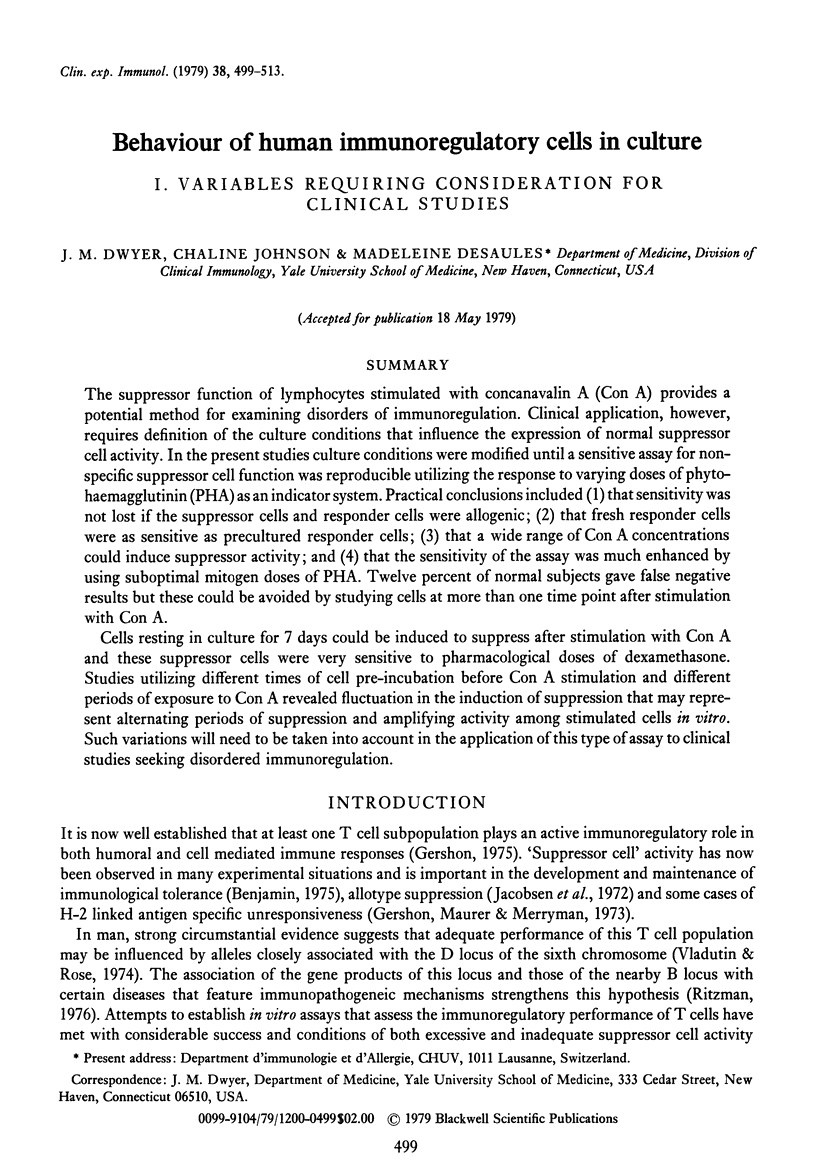
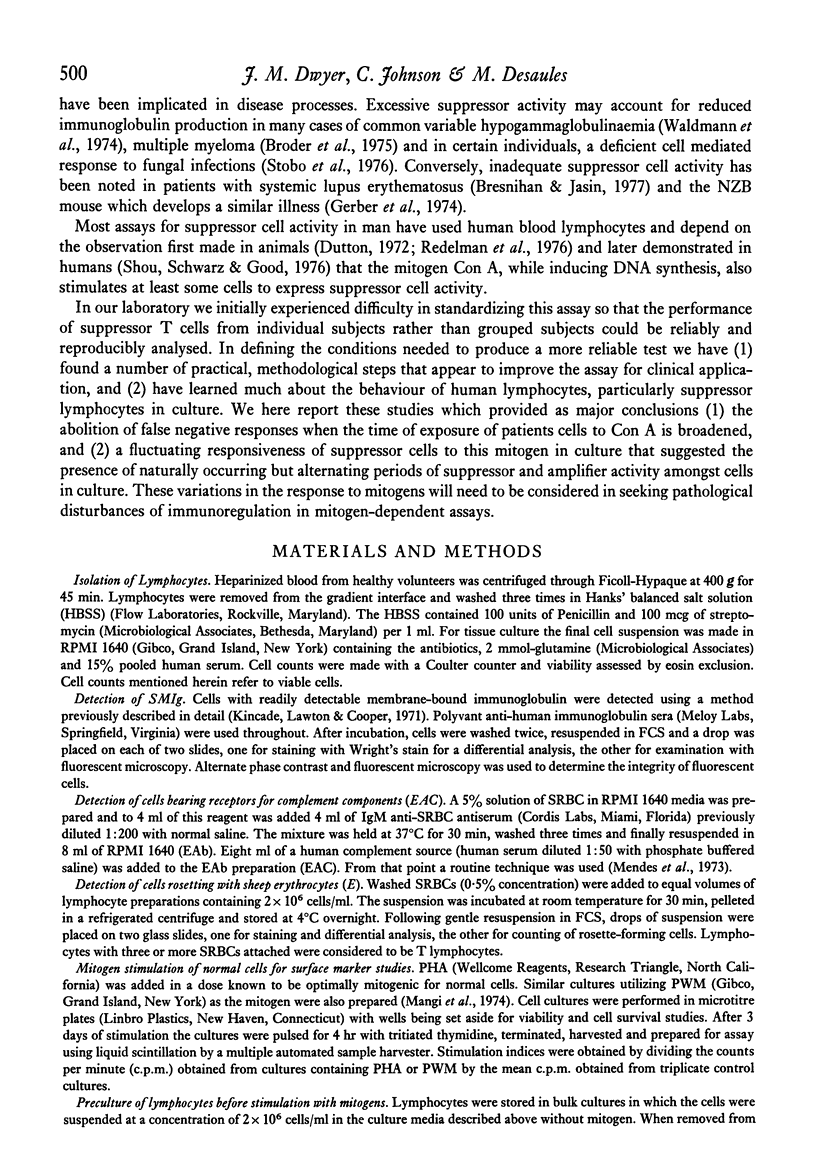
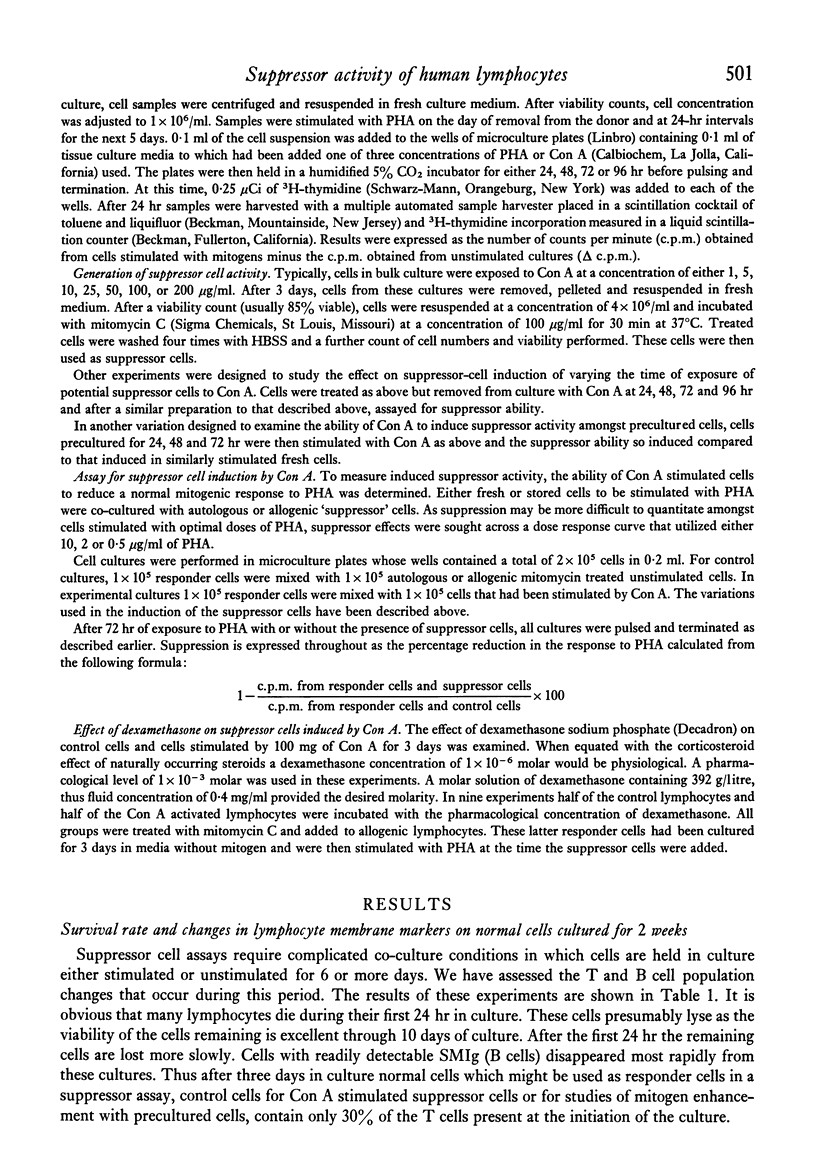
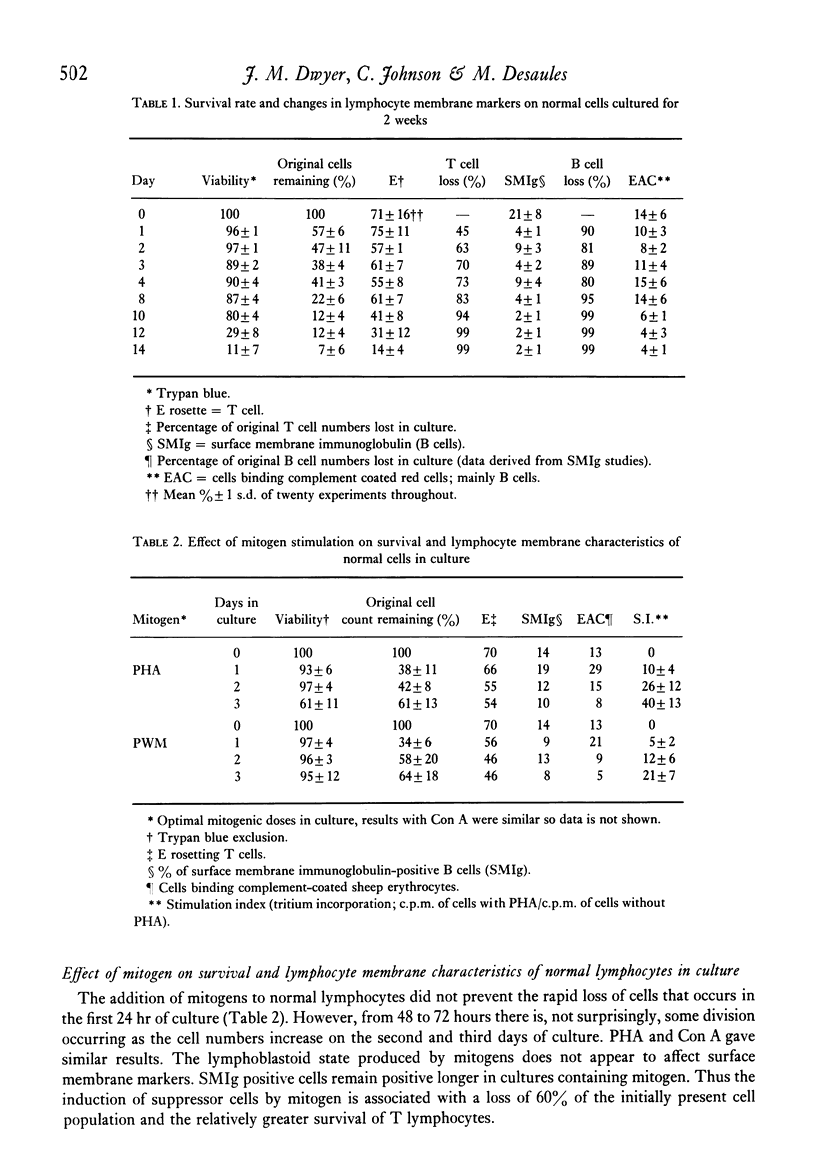
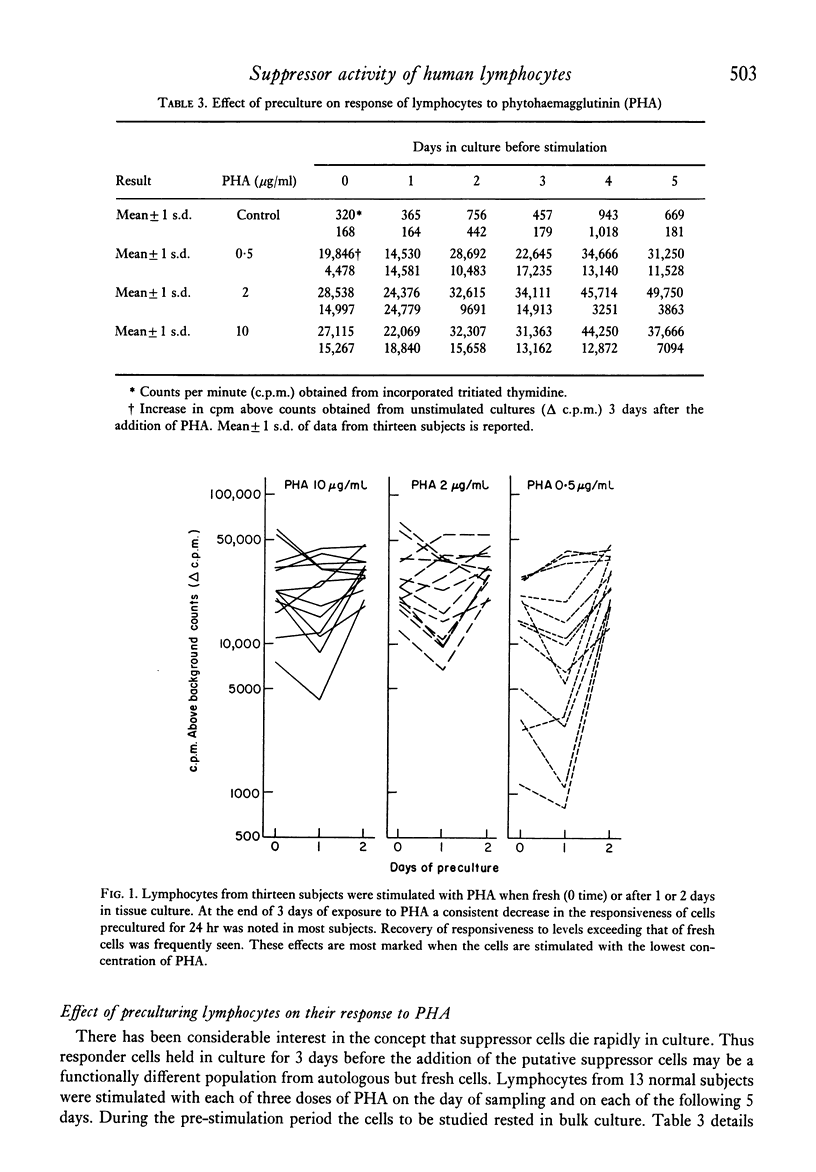

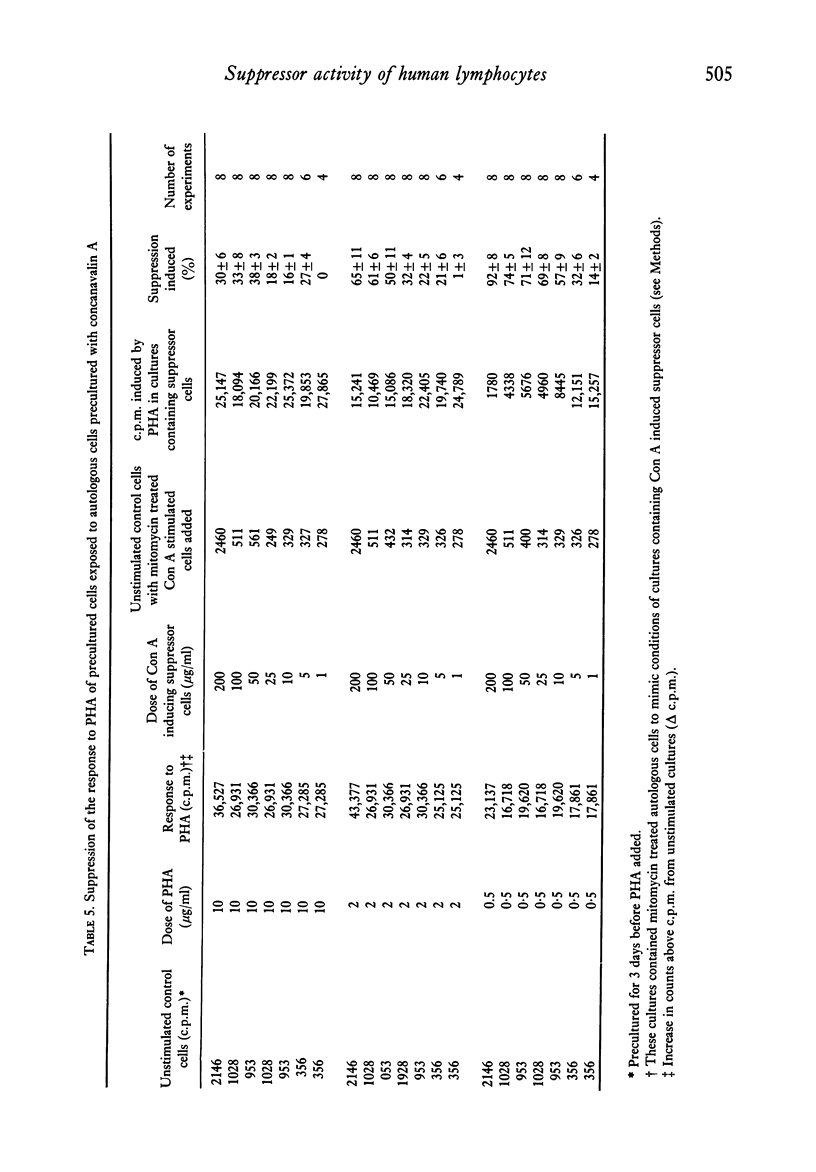
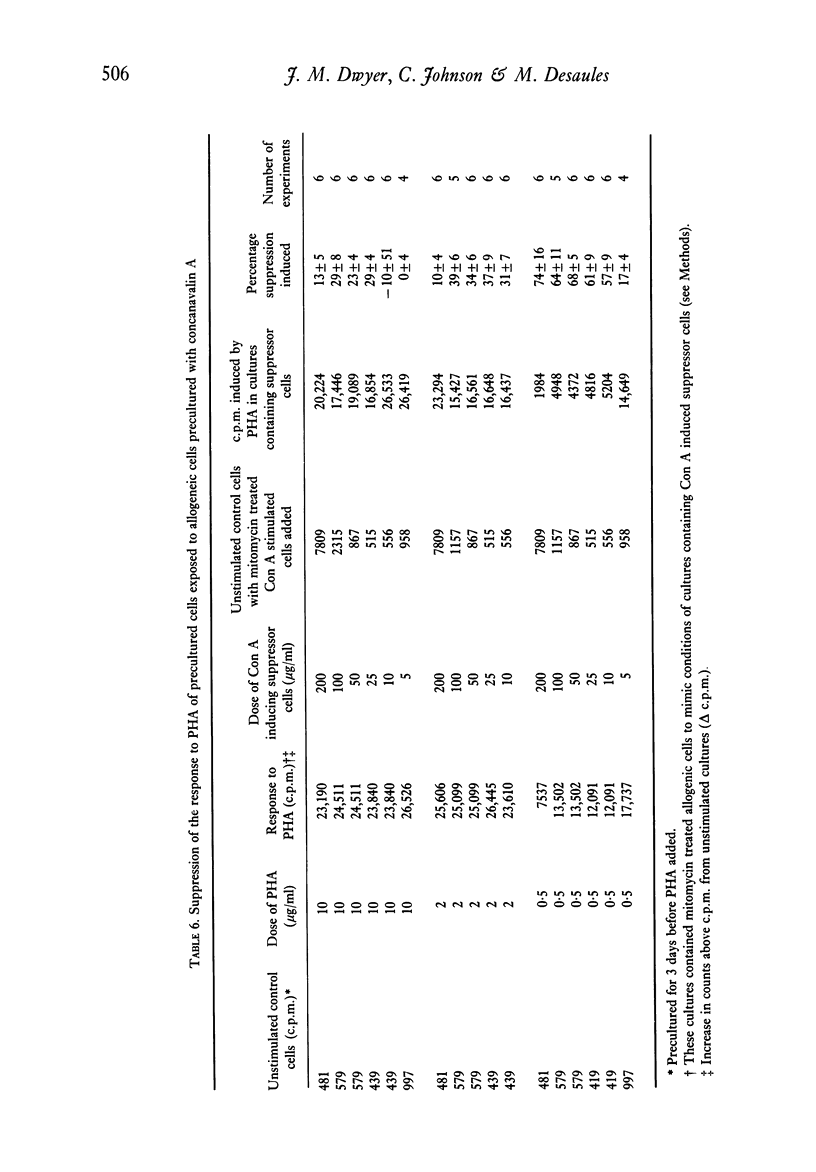

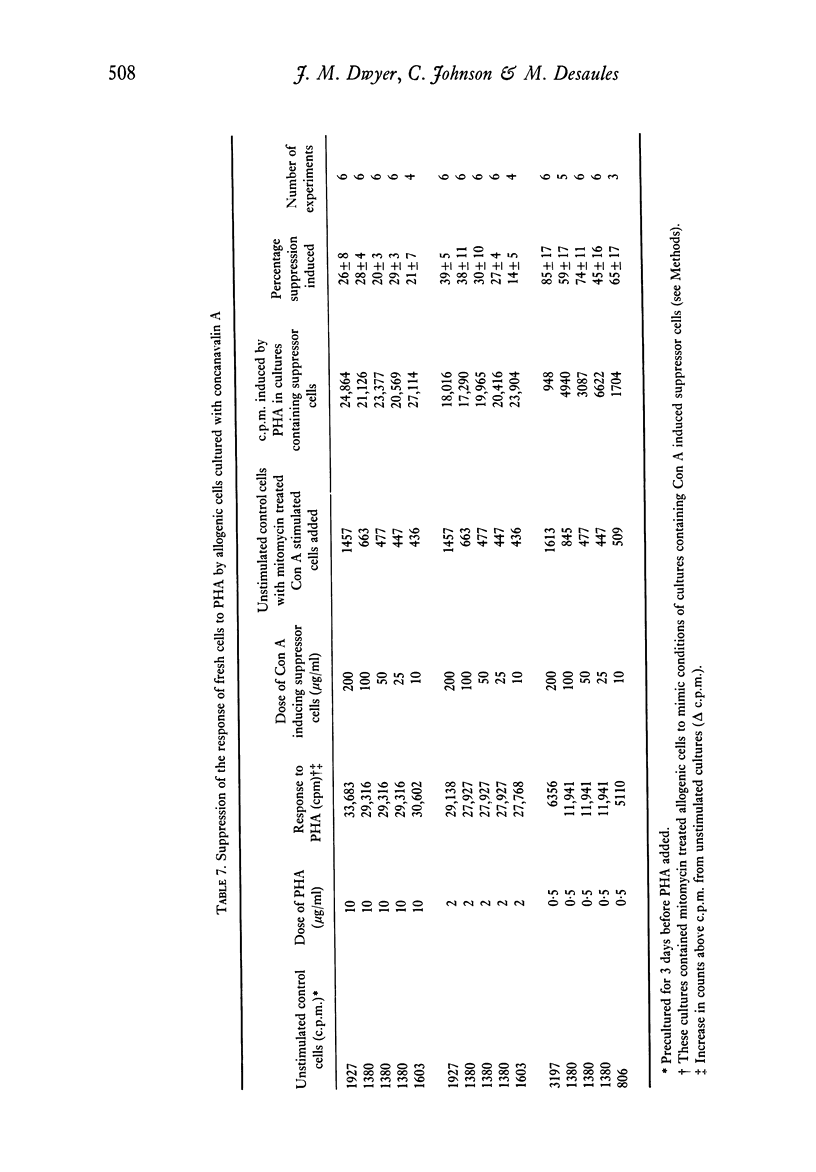
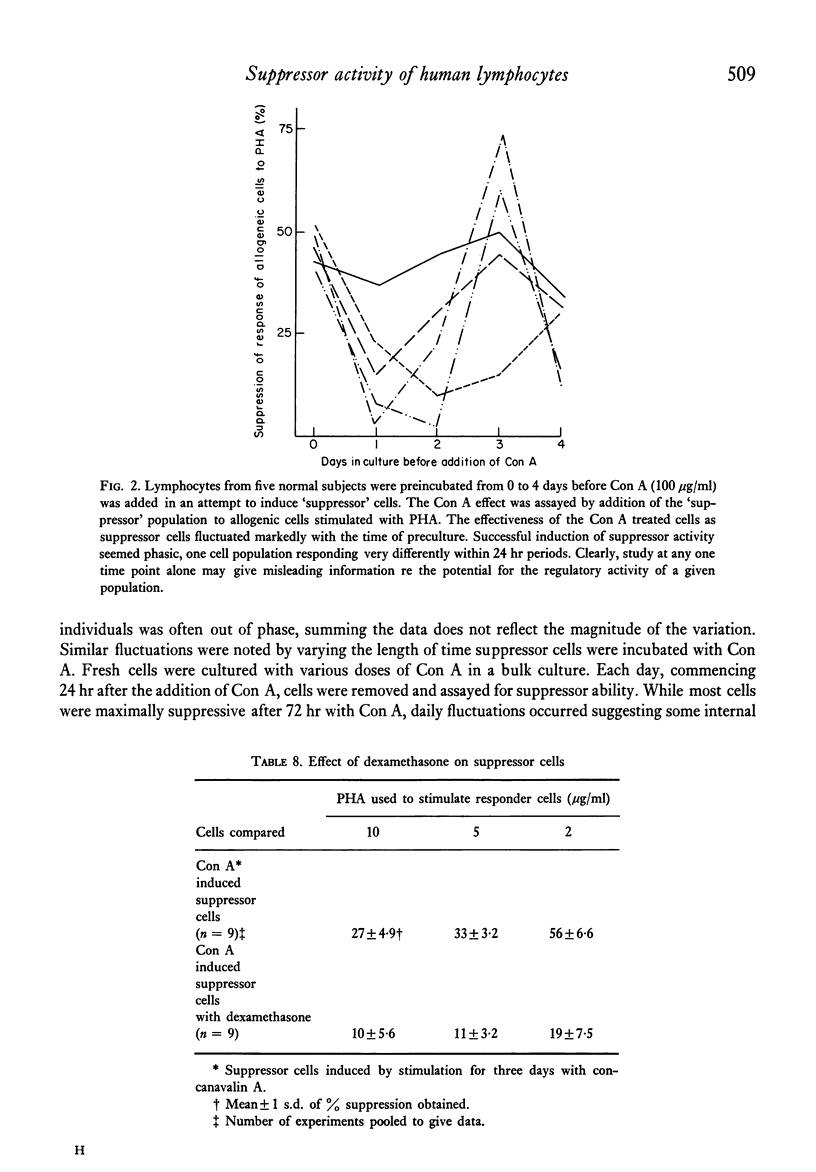
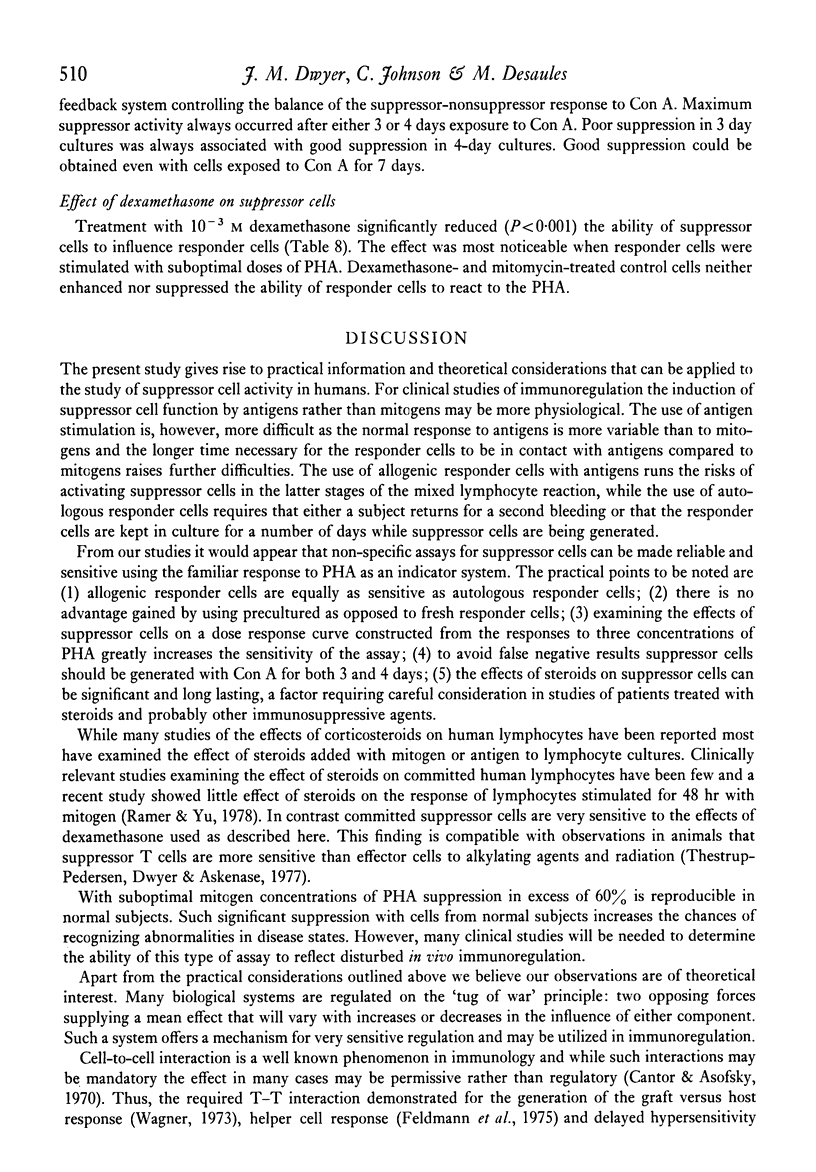
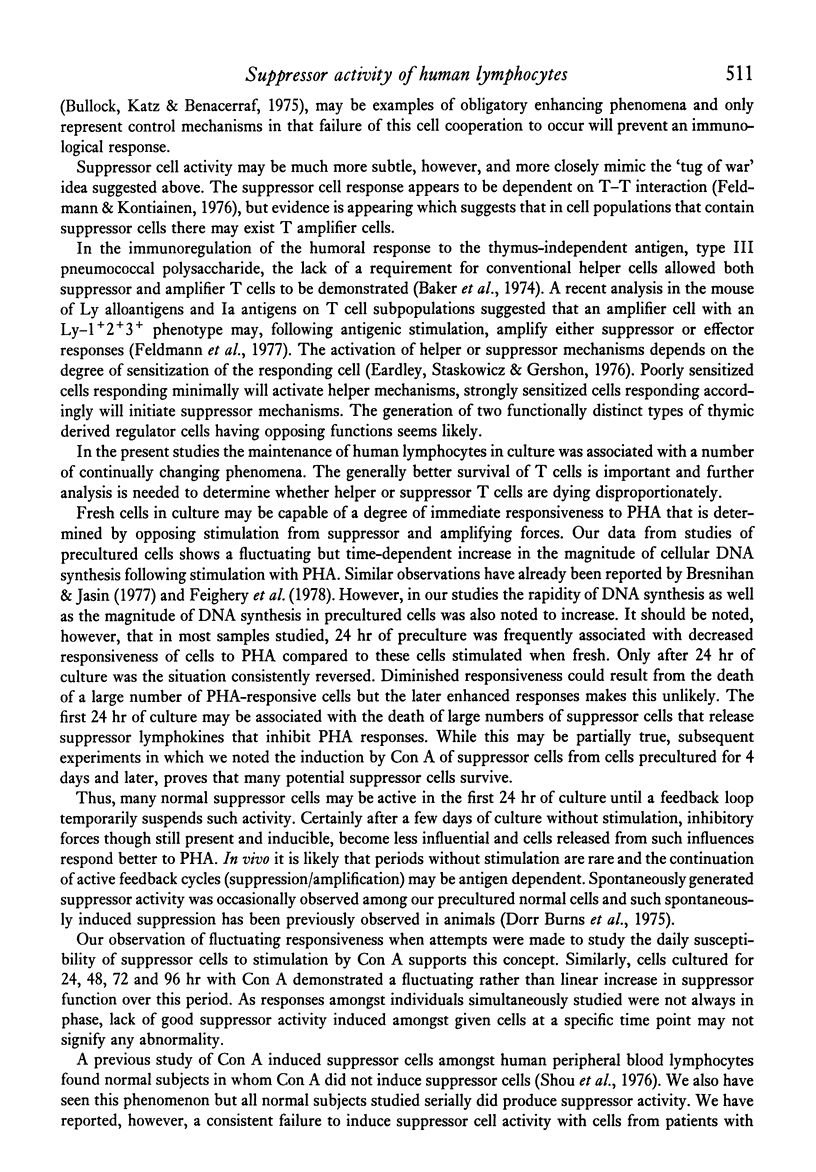
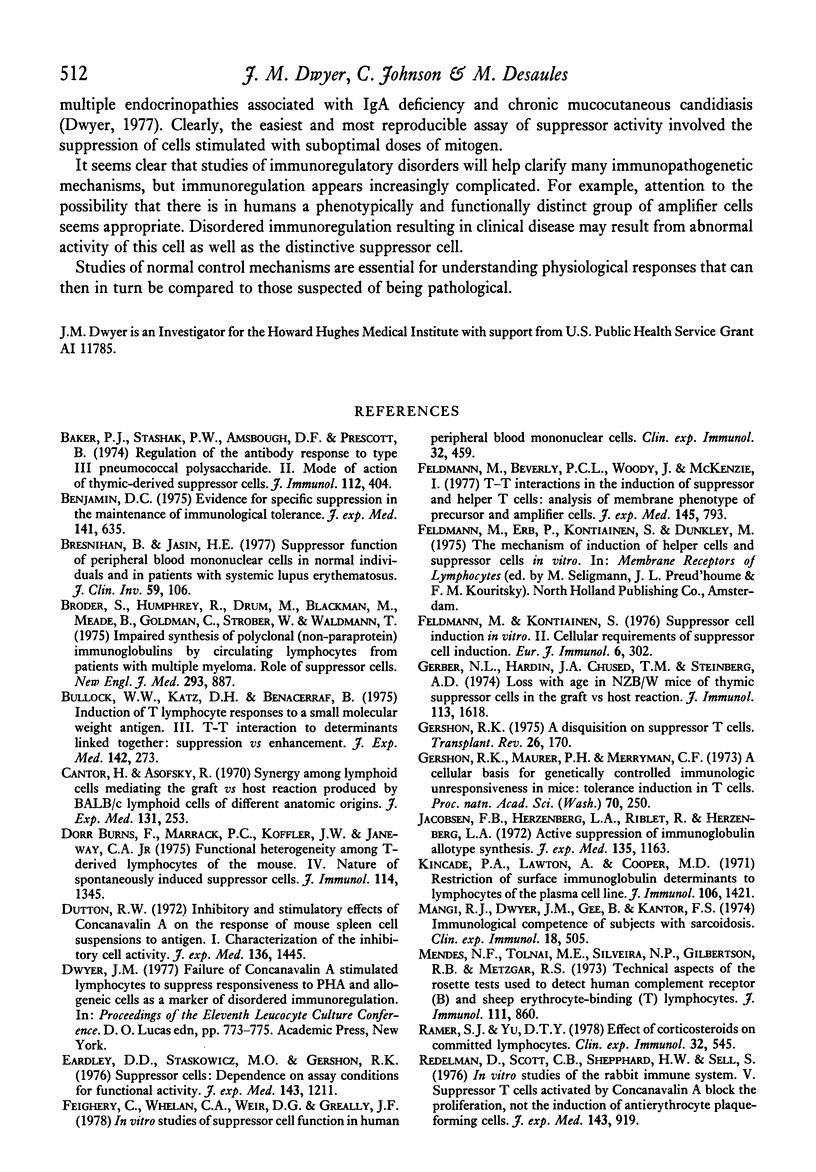
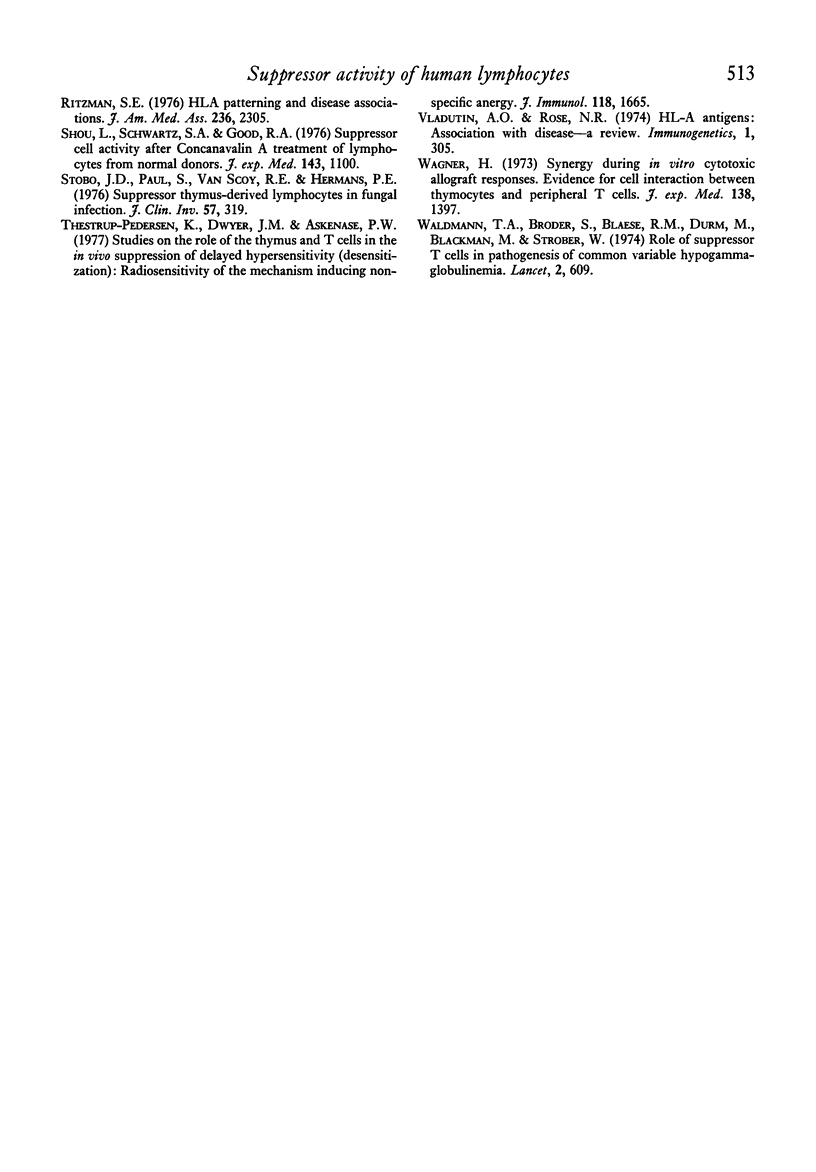
Selected References
These references are in PubMed. This may not be the complete list of references from this article.
- Baker P. J., Stashak P. W., Amsbaugh D. F., Prescott B. Regulation of the antibody response to type 3 pneumococcal polysaccharide. II. Mode of action of thymic-derived suppressor cells. J Immunol. 1974 Jan;112(1):404–409. [PubMed] [Google Scholar]
- Benjamin D. C. Evidence for specific suppression in the maintenance of immunologic tolerance. J Exp Med. 1975 Mar 1;141(3):635–646. doi: 10.1084/jem.141.3.635. [DOI] [PMC free article] [PubMed] [Google Scholar]
- Bresnihan B., Jasin H. E. Suppressor function of peripheral blood mononuclear cells in normal individuals and in patients with systemic lupus erythematosus. J Clin Invest. 1977 Jan;59(1):106–116. doi: 10.1172/JCI108607. [DOI] [PMC free article] [PubMed] [Google Scholar]
- Broder S., Humphrey R., Durm M., Blackman M., Meade B., Goldman C., Strober W., Waldmann T. Impaired synthesis of polyclonal (non-paraprotein) immunoglobulins by circulating lymphocytes from patients with multiple myeloma Role of suppressor cells. N Engl J Med. 1975 Oct 30;293(18):887–892. doi: 10.1056/NEJM197510302931801. [DOI] [PubMed] [Google Scholar]
- Dutton R. W. Inhibitory and stimulatory effects of concanavalin A on the response of mouse spleen cell suspensions to antigen. I. Characterization of the inhibitory cell activity. J Exp Med. 1972 Dec 1;136(6):1445–1460. doi: 10.1084/jem.136.6.1445. [DOI] [PMC free article] [PubMed] [Google Scholar]
- Eardley D. D., Staskawicz M. O., Gershon R. K. Suppressor cells: dependence on assay conditions for functional activity. J Exp Med. 1976 May 1;143(5):1211–1219. doi: 10.1084/jem.143.5.1211. [DOI] [PMC free article] [PubMed] [Google Scholar]
- Feighery C., Whelan C. A., Weir D. G., Greally J. F. In vitro studies of suppressor cell function in human peripheral blood mononuclear cells. Clin Exp Immunol. 1978 Jun;32(3):459–465. [PMC free article] [PubMed] [Google Scholar]
- Feldmann M., Beverley P. C., Woody J., McKenzie I. F. T-T interactions in the induction of suppressor and helper T cells: analysis of membrane phenotype of precursor and amplifier cells. J Exp Med. 1977 Apr 1;145(4):793–801. doi: 10.1084/jem.145.4.793. [DOI] [PMC free article] [PubMed] [Google Scholar]
- Feldmann M., Kontiainen S. Suppressor cell induction in vitro. II. Cellular requirements of suppressor cell induction. Eur J Immunol. 1976 Apr;6(4):302–305. doi: 10.1002/eji.1830060413. [DOI] [PubMed] [Google Scholar]
- Gerber N. L., Hardin J. A., Chused T. M., Steinberg A. D. Loss with age in NZB-W mice of thymic suppressor cells in the graft-vs-host reaction. J Immunol. 1974 Nov;113(5):1618–1625. [PubMed] [Google Scholar]
- Gershon R. K. A disquisition on suppressor T cells. Transplant Rev. 1975;26:170–185. doi: 10.1111/j.1600-065x.1975.tb00179.x. [DOI] [PubMed] [Google Scholar]
- Gershon R. K., Maurer P. H., Merryman C. F. A cellular basis for genetically controlled immunologic unresponsiveness in mice: tolerance induction in T-cells. Proc Natl Acad Sci U S A. 1973 Jan;70(1):250–254. doi: 10.1073/pnas.70.1.250. [DOI] [PMC free article] [PubMed] [Google Scholar]
- Jacobson E. B., Herzenberg L. A., Riblet R., Herzenberg L. A. Active suppression of immunoglobulin allotype synthesis. II. Transfer of suppressing factor with spleen cells. J Exp Med. 1972 May 1;135(5):1163–1176. doi: 10.1084/jem.135.5.1163. [DOI] [PMC free article] [PubMed] [Google Scholar]
- Kincade P. W., Lawton A. R., Cooper M. D. Restriction of surface immunoglobulin determinants to lymphocytes of the plasma cell line. J Immunol. 1971 May;106(5):1421–1423. [PubMed] [Google Scholar]
- Mangi R. J., Dwyer J. M., Gee B., Kantor F. S. The immunological competence of subjects with sarcoidosis. Clin Exp Immunol. 1974 Dec;18(4):505–517. [PMC free article] [PubMed] [Google Scholar]
- Mendes N. F., Tolnai M. E., Silveira N. P., Gilbertsen R. B., Metzgar R. S. Technical aspects of the rosette tests used to detect human complement receptor (B) and sheep erythrocyte-binding (T) lymphocytes. J Immunol. 1973 Sep;111(3):860–867. [PubMed] [Google Scholar]
- Ramer S. J., Yu D. T. Effect of corticosteroids on committed lymphocytes. Clin Exp Immunol. 1978 Jun;32(3):545–553. [PMC free article] [PubMed] [Google Scholar]
- Redelman D., Scott C. B., Sheppard H. W., Jr, Sell S. In vitro studies of the rabbit immune system. V. Suppressor T cells activated by concanavalin A block the proliferation, not the induction of antierythrocyte plaque-forming cells. J Exp Med. 1976 Apr 1;143(4):919–936. doi: 10.1084/jem.143.4.919. [DOI] [PMC free article] [PubMed] [Google Scholar]
- Ritzmann S. E. HLA patterns and disease associations. JAMA. 1976 Nov 15;236(20):2305–2309. [PubMed] [Google Scholar]
- Shou L., Schwartz S. A., Good R. A. Suppressor cell activity after concanavalin A treatment of lymphocytes from normal donors. J Exp Med. 1976 May 1;143(5):1100–1110. doi: 10.1084/jem.143.5.1100. [DOI] [PMC free article] [PubMed] [Google Scholar]
- Stobo J. D., Paul S., Van Scoy R. E., Hermans P. E. Suppressor thymus-derived lymphocytes in fungal infection. J Clin Invest. 1976 Feb;57(2):319–328. doi: 10.1172/JCI108283. [DOI] [PMC free article] [PubMed] [Google Scholar]
- Thestrup-Pedersen K., Dwyer J. M., Askenase P. W. Studies on the role of the thymus and T cells in the in vivo suppression of delayed hypersensitivity (desensitization): radiosensitivity of the mechanism inducing nonspecific anergy. J Immunol. 1977 May;118(5):1665–1671. [PubMed] [Google Scholar]
- Wagner H. Synergy during in vitro cytotoxic allograft responses. I. Evidence for cell interaction between thymocytes and peripheral T cells. J Exp Med. 1973 Dec 1;138(6):1379–1397. doi: 10.1084/jem.138.6.1379. [DOI] [PMC free article] [PubMed] [Google Scholar]
- Waldmann T. A., Durm M., Broder S., Blackman M., Blaese R. M., Strober W. Role of suppressor T cells in pathogenesis of common variable hypogammaglobulinaemia. Lancet. 1974 Sep 14;2(7881):609–613. doi: 10.1016/s0140-6736(74)91940-0. [DOI] [PubMed] [Google Scholar]


